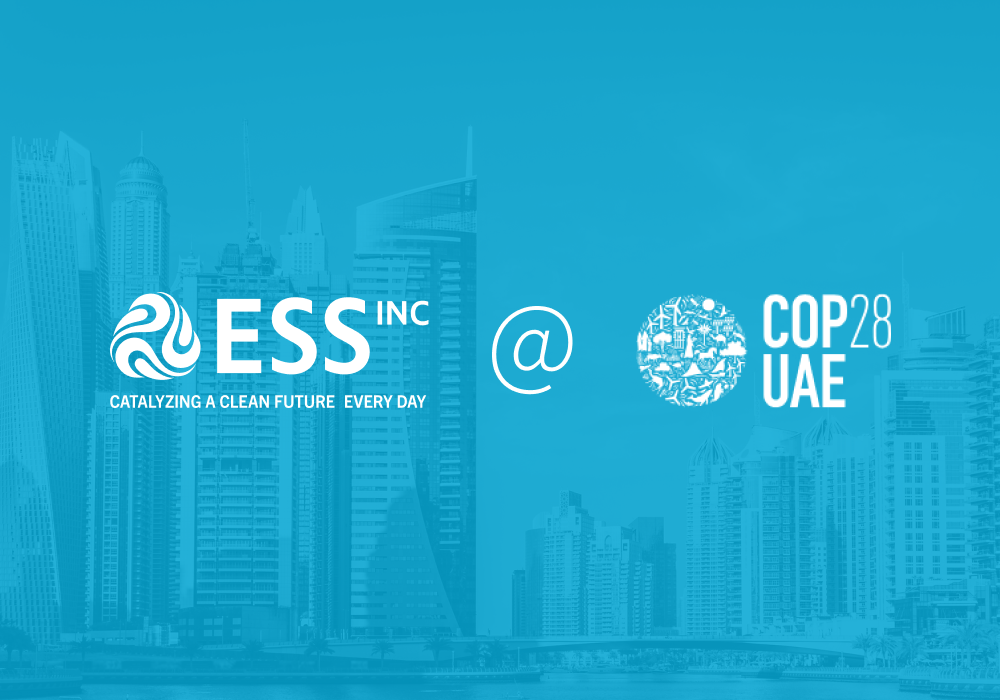This month, world leaders again gathered for the 28th U.N.F.C.C.C. Conference of the Parties (COP 28) in Dubai to discuss how to further accelerate global decarbonization. I joined with a number of ESS’ partners to share progress on existing projects and discuss strategies to drive the clean energy transition by rapidly deploying renewable generation and long-duration energy storage (LDES).
The good news is that, in discussion after discussion, it is clear there is broad consensus that the time to act is now and that new technologies will play a central role in reaching climate targets and building zero carbon grids in parts of the world that remain energy insecure. LDES specifically is now broadly recognized as key to achieving decarbonization while ensuring reliability and is regularly mentioned in any discussion of a clean energy grid. However, it is not just the providers of new technologies, like ESS, who will lead this effort.
Yesterday’s major carbon emitters are lining up to become tomorrow’s clean energy leaders.
With the announcement of a global commitment to transition away from fossil fuels and commitments to achieve carbon neutrality by 2050, legacy energy companies see the writing on the wall: decarbonization is the future, and the time to move is now. This builds on earlier action at COP 28, including 130+ countries signing on to triple renewables by 2030 and an exciting global initiative to “Supercharge Energy Storage” led by the Clean Energy Ministerial with support across Europe, Australia, the U.S. and many others.
Thanks to the convening efforts of Breakthrough Energy and the Energy Resilience Leadership Group, new dialogues and partnerships are emerging between these legacy players, new clean tech providers, government regulators and other stakeholders with the potential to rapidly accelerate decarbonization and deploy innovative new solutions. COP provides a critical venue to convene these diverse stakeholder groups and strengthen the partnerships we will need to tackle this challenge.
The path forward requires that we transition from coal to clean.
In Dubai, I had the opportunity to check in with the CEO of LEAG, Thorston Kramer, a key ESS partner. LEAG is a major German coal mining and energy generation company with aggressive plans to lead the post-coal future. Earlier this year, we announced an initial agreement with LEAG to develop the largest clean energy hub in Europe using ESS technology. When complete, this project is expected to consist of 7-14 GW of renewable generation paired with 2-3 GWh of LDES. This project will deliver green baseload energy and provide a case study for legacy coal generators worldwide. Initial engineering work is underway and we are excited to get building.
Systems to deliver reliable 24/7/365 clean energy are already under construction.
As large coal and fossil generators increasingly sign on to the decarbonization effort, innovative and forward-thinking utilities are already leading the way, creating “postcards from the future” that show it is possible today to deliver sustainable, cost-effective and reliable power.
The Sacramento Municipal Utility District (SMUD) is widely recognized as one of these leaders and was represented by CEO and General Manager Paul Lau. He shared about the utility’s industry-leading 2030 Clean Energy Vision, which aims to fully decarbonize their energy supply in just 6 years. There is no doubt that LDES will be a central part of their strategy and ESS is proud to partner with them to make their bold vision a reality. In September, we announced the commissioning of our first deployment with SMUD, with further deliveries of ESS systems in coming years. Eventually, we plan to deploy 2 GWh of ESS iron flow technology on SMUD’s system to balance intermittent renewable generation and enable the complete decarbonization of Sacramento’s energy supply.
There has been much progress, but there is much to do.
Discussions at COP have evolved significantly over the years. No longer is there a question of whether it is possible to decarbonize the global economy, or whether there will be unacceptable economic or development tradeoffs required to protect the climate. Instead, leaders are focused on the best ways to achieve that goal. It was a pleasure and privilege to share ESS’ progress and success with our stakeholders from around the world and I look forward to further discussions with global leaders as we build a resilient, sustainable and prosperous future.
